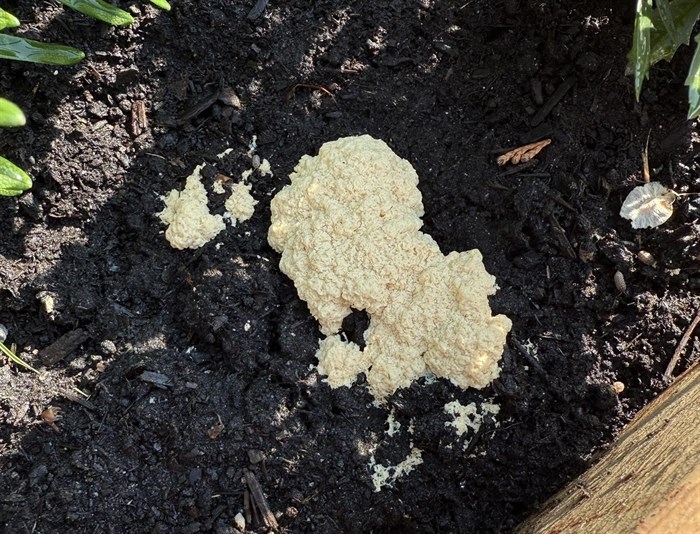
This dog vomit slime mould was found in a garden in Kelowna.
Image Credit: SUBMITTED/ Tracey Cochrane
June 08, 2025 - 4:00 AM
Slimy masses resembling piles of vomit or scrambled eggs have appeared in some Okanagan gardens this spring, attached to decaying wood and organic materials.
Kelowna resident Tracey Cochrane scooped a white, vomit-like pile out of her raised garden bed at the beginning of June.
“I saw it when I took my coffee out to enjoy a morning walk around my garden bed,” she told iNFOnews.ca. “I almost dropped my coffee when I saw that."
Cochrane said she had mixed a bag of leaves into the soil and put an irrigation line down the middle of the bed in May.
“I must have had the irrigation set for too long and it set off the fungus,” she said. “I scooped it out as soon as I saw it but it was there again the next day.”
It wasn’t until Cochrane turned the irrigation off completely for a few days and reset it for a shorter time period that the slimy blob disappeared.
Commonly known as dog vomit slime mould, the spongy, bright blobs are not a fungus but a plasmodial slime mould, that is a group of primitive organisms more closely related to amoebas and certain seaweeds, according to the Mushroom Appreciation website.
The slime moulds can be found in late spring through to fall in warm, humid conditions around the world, often appearing after rainfall or excessive watering.
The dog vomit slime mould is one of the most recognizable and distinctive slime moulds and it does not have any lookalikes.
The mould starts as a slimy mass anywhere from white to bright yellow with a foamy texture, and as it matures it expands into a cushion-like structure called an aethalium which is whitish, tan, bright yellow or orange.
When the structure dries out it hardens, and under its crust are millions of spores that are released when the structure is disturbed by animals, people or storms, and dispersed to by the wind to new areas. Once the spores are gone the slime mould disintegrates.
READ MORE: 'Very good year': Bumper crop of morel mushrooms in Thompson-Okanagan
The transition from initial slime to spore dispersal takes just a few days, and as gross as the blobs look, they are harmless and have an important ecological function.
Dog vomit slime mould is a decomposer, breaking down organic matter and returning the nutrients to the soil.
Dog slime mould is a resilient organism and complete elimination isn’t likely and it will return every year. Gardeners can reduce its presence by raking the slime moulds to break it up and dry it out, stirring mulch to dry the area out and reducing excessive watering.
To contact a reporter for this story, email Shannon Ainslie or call 250-819-6089 or email the editor. You can also submit photos, videos or news tips to the newsroom and be entered to win a monthly prize draw.
We welcome your comments and opinions on our stories but play nice. We won't censor or delete comments unless they contain off-topic statements or links, unnecessary vulgarity, false facts, spam or obviously fake profiles. If you have any concerns about what you see in comments, email the editor in the link above. SUBSCRIBE to our awesome newsletter here.
News from © iNFOnews, 2025